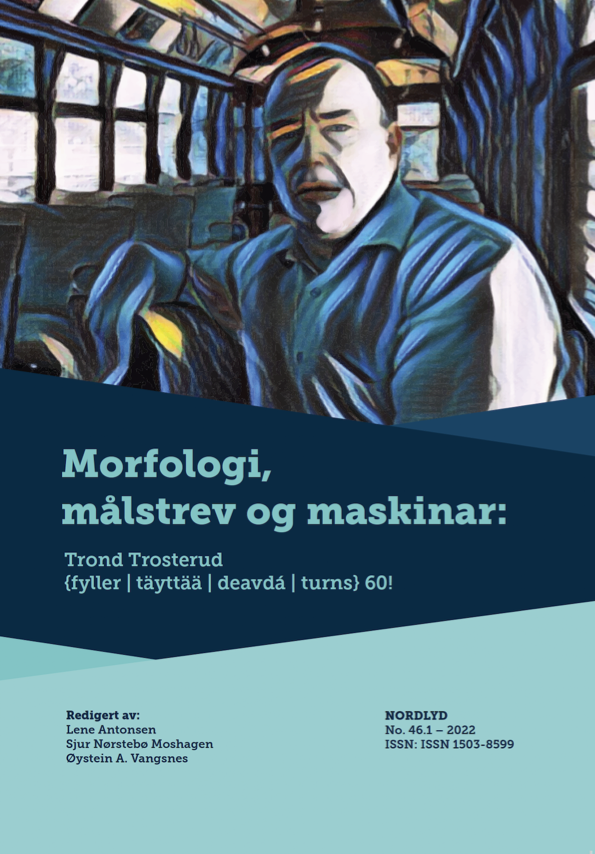Anarâškielâ postpositioi pelni já piälán čäällim sierâ já oohtân tievâdâsâinis SIKOR-tekstâčuágálduvâst
DOI:
https://doi.org/10.7557/12.6384Keywords:
postposition, orthography, Giellatekno, language revitalisation, language variationAbstract
Inari Saami does not have a strong written tradition. The current orthography was adopted as recently as the 1990s, and the revitalization process is beginning only now to shift its focus from increasing the number of speakers to strengthening the literacy of the language. This article studies the Inari Saami postpositions pelni and piälán as well as their shorter forms peln/beln and pel/bel. The main question is whether these postpositions are joined to the noun preceding them or stand after it as separate words. The research is based on the SIKOR Inari Saami free corpus developed by the Giellatekno team. The postpositions have been analyzed semantically taking into account the frequency with which they occur in the literature. They have been divided into four semantic groups: 1) place, 2) orientation and direction, 3) time and 4) other semantic categories. The long forms pelni and piälán are mostly written as separate words – except for when they are used to express orientation or direction – whereas the short forms peln/beln and pel/bel are usually joined to the preceding word other than in time expressions. Alternative explanations for such variation are also discussed.
References
Antonsen, Lene, Trond Trosterud, Marja-Liisa Olthuis já Erika Sarivaara. 2016. Modelling the Inari Saami morphophonology as a finite state transducer. Almostitmist The Second International Workshop on Computational Linguistics for Uralic Languages: 3–13, toimâttâm Tommi A. Pirinen, Eszter Simon já Francis M. Tyers já Veronica Vincze. Szegedi Tudományegyetem, Szeged. https://www.academia.edu/72593469/Report_on_the_Second_International_Workshop_on_Computational_Linguistics_for_Uralic_Languages
Eronen, Riitta, Sari Maamies já Anneli Räikkälä. 1996. Yhdyssanat. Kielikello 4/1996. https://www.kielikello.fi/-/yhdyssanat. [Čujottum 28.3.2022.]
Ijäs, Johanna Johansen. 2011. Davvisámegiela finihtta vearbahámiid sojahanvuogádaga oččodeapmi vuollel golmmajahkásaš máná gielas. Davvi Girji, Kárašjohka.
ILWB = Itkonen, Erkki (hrsg.), Raija Bartens já Lea Laitinen (unter Mitarbeit). 1986–1991. Inarilappisches Wörterbuch I–IV. Lexica Societatis Fenno-Ugricae XX. Suomalais-Ugrilainen Seura, Helsinki.
Kielitoimiston ohjepankki: Yhdyssana vai ei. http://www.kielitoimistonohjepankki.fi/ohje/112. [Čujottum 9.12.2021.]
Kielitoimiston ohjepankki: Yhdyssana vai ei. http://www.kielitoimistonohjepankki.fi/ohje/129. [Čujottum 9.12.2021.]
Kielitoimiston sanakirja. 2021. Kotimaisten kielten keskuksen verkkojulkaisuja 35. Kotimaisten kielten keskus, Helsinki. URN:NBN:fi:kotus-201433. https://www.kielitoimistonsanakirja.fi. Peividuvvee almosittem. Peividum 11.11.2021 [Čujottum 08.12.2021.]
Morottaja, Petter, Marja-Liisa Olthuis, Trond Trosterud já Lene Antonsen. 2018. Anarâškielâ tivvoomohjelm. Kielâ-já ortografiafeeilâi kuorrâm tivvoomohjelmáin. Almostitmist Gielladieđalaš čállin sámegillii – Gii das berošta? Dutkansearvvi dieđalaš áigečála Vol. 2 Issue 2: 63–84, toimâttâm Marja-Liisa Olthuis já Irja Seurujärvi-Kari. https://www.dutkansearvi.fi/volume-2-issue-2-fi/.
Morottaja, Petter já Olthuis, Marja-Liisa 2022: Inarinsaamen taivutusoppi. Sämitigge, Aanaar.
Nettidigisäänih. Anarâškielâ sänikirje. 2021. UiT The Arctic University of Norway, Giellatekno, Tromsø. Peividuvvee almostittem. https://saanih.oahpa.no/ [Čujottum 08.12.2021.]
Nickel, Klaus Peter. 1994. Samisk grammatikk. Davvi Girji, Kárašjohka.
Olthuis, Marja-Liisa. 2000. Inarinsaamen kielen vuosisadat. Virittäjä, Vol. 104 nr. 4: 568–575.
Olthuis, Marja-Liisa. 2008. Inarinsaamen huoltoa ja elvytystä. Kielikello 1/2008. https://www.kielikello.fi/-/inarinsaamen-huoltoa-ja-elvytysta.
Olthuis, Marja-Liisa, Suvi Kivelä já Tove Skutnabb-Kangas. 2013. Revitalising Indigenous Languages – How to Recreate a Lost Generation. Multilingual Matters, Bristol. https://doi.org/10.21832/9781847698896.
Olthuis, Marja-Liisa já Trond Trosterud. 2015. Inarinsaamen lingvistinen suunnittelu kieliteknologian valossa. Almostitmist Vähemmistökielten revitalisaatio. AGON n:o 45–46. 1–2/2015, toimâttâm Annika Pasanen já Sanna Valkonen. http://agon.fi/article/inarinsaamen-lingvistinen-suunnittelu-kieliteknologian-valossa/.
Olthuis, Marja-Liisa, Trond Trosterud, Erika Katjaana Sarivaara, Petter Morottaja já Eljas Niskanen. 2021. Strengthening the Literacy of an Indigenous Language Community: Methodological Implications of the Project Čyeti čälled anarâškielân ‘One Hundred Writers for Aanaar Saami’. Almostitmist Indigenous Research Methodologies in Sámi and Global Contexts. New Research, New Voices: 175–200, toimâttâm Pirjo Kristiina Virtanen, Pigga Keskitalo já Torjer Olsen. Brill Sense, Leiden. https://doi.org/10.1163/9789004463097_008.
Olthuis, Marja-Liisa. 2021. Nubástusâi čohčâ. Anarâš 2/2021:3. https://drive.google.com/drive/folders/0ByPNya2iI49hcGI1RXZ2MV9LbFU?resourcekey=0-1Su9TqVEoPYNlgiHzkxWVQ.
Pasanen, Annika. 2015. Kuávsui já peeivičuovâ. 'Sarastus ja päivänvalo' : Inarinsaamen kielen revitalisaatio. Uralica Helsingiensia 9. Suomalais-Ugrilainen Seura ja Helsingin yliopisto, Helsinki.
Sammallahti, Pekka. 2020. Pekka Sammallahden pohjoissaame-suomi-sanakirja. Divvun, Romsa. [Čujottum 9.12.2021.] http://satni.org/sammallahtismefin.
SIKOR. UiT Norgga árktalaš universitehta ja Norgga Sámedikki sámi teakstačoakkáldat, Veršuvdna 01.10.2021, http://gtweb.uit.no/korp/.
Ylikoski, Jussi. 2014. Davvisámegiela ‑ráigge – substantiiva, advearba, postposišuvdna vai kásus? Sámi Dieđalaš Áigečála 2/2014: 47–70. https://site.uit.no/aigecala/files/2015/04/SDA-2-2014-ylikoski.pdf.
Downloads
Published
Issue
Section
License
Copyright (c) 2022 Marja-Liisa Olthuis, Petter Morottaja, Fabrizio Brecciaroli

This work is licensed under a Creative Commons Attribution-NonCommercial 4.0 International License.





